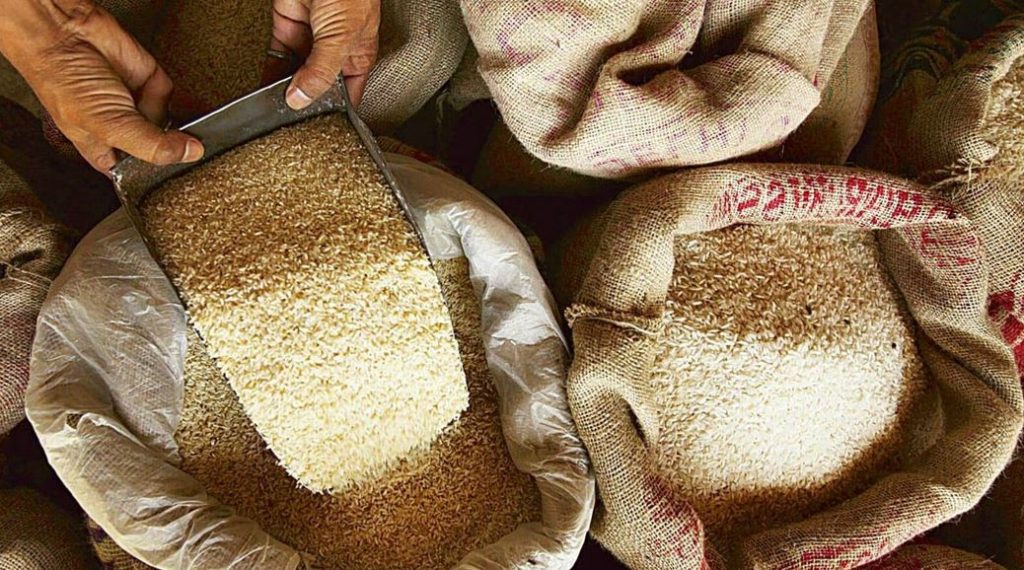Tags
Rice imports up Rs 11 billion this year despite national push for self-sufficiency
The stagnation in domestic rice production is attributed to various factors including fallow arable land, lack of improved seed varieties, inadequate chemical fertilizers and limited irrigation infrastructure.

By DILIP PAUDEL
As the government marks the 22nd National Rice Day on Asar 15 (June 29) today with the slogan ‘Intensification in Rice Cultivation: Food Security and Self-Reliance’, official data paints a contrasting picture—rice and paddy imports in the 11 months of the current Fiscal Year (FY) have already neared Rs 39 billion.
According to the Department of Customs, from Shrawan to Jestha in FY 2024/25, Nepal imported rice and paddy worth Rs 38.94 billion. This volume totals 753,305 metric tons, reflecting an average monthly import worth over Rs 3 billion. Compared to the same period last year, rice imports have increased by nearly Rs 11 billion. During the first 11 months of FY 2023/24, imports stood at around Rs 21 billion. Likewise, in FY 2022/23, the total import during the same period was Rs 33.63 billion.
The stagnation in domestic rice production is attributed to various factors including fallow arable land, lack of improved seed varieties, inadequate chemical fertilizers and limited irrigation infrastructure. The Department of Agriculture has stated that the increased imports this year are also due to India’s waiver on buffer stock rice, making it easier and cheaper for Nepali traders to import.
Prakash Kumar Sanjel, Director General of the Department of Agriculture (DoA), noted that consumer preference for fine, aromatic rice and the declining area under cultivation are key contributors. “Expected productivity levels have not been achieved, and the area under rice cultivation has decreased,” said Sanjel. Last year, the rice plantation area decreased by 1 percent.
This fiscal year, 1,420,636 hectares of land have been used for rice cultivation, yielding 5.94 million metric tons. However, Nepal requires around 7 million metric tons of rice annually, leaving a shortfall of approximately 1 million metric tons. Nepali consumers continue to prefer imported fine and fragrant rice from neighboring and overseas countries.
This year alone, Nepal imported fine rice worth around Rs 211.5 million from the US. Imports have also been recorded from countries such as the Philippines, Thailand, Japan, Indonesia, Italy, the UK, and Namibia.
Sanjel attributes the rising imports also to traders stockpiling Indian rice procured at lower prices. An informal study cited by the DoA shows that although the annual per capita rice requirement is 121 kg, consumption has reached 138 kg, indicating a cultural shift in eating habits.
To enhance production, experts stress the need for improved seeds, timely supply of fertilizers, better irrigation, planting equipment and modern technology. Traditional, subsistence-based rice farming methods are still widely prevalent, hindering productivity.
Experts also point out that poor organic content in soil and lack of balanced fertilizers further impact yields. Currently, the average production is around 4.2 metric tons per hectare.
“If we can raise this to 5-6 metric tons per hectare, we can substitute imports,” said Sanjel, emphasizing the role of technology and better seeds.
The government has prioritized expanding rice cultivation. In FY 2025/26, a special program has been announced to boost Chaite Dhan (spring rice) production in 22 Terai districts. With an investment of Rs 330 million, the initiative aims to produce an additional 1.2 million tons. The target is to expand the current Chaite Dhan cultivation area from 110,000 hectares to 200,000 hectares
https://myrepublica.nagariknetwork.com/news/rice-imports-up-rs-11-billion-this-year-despite-national-push-for-self-suff-24-61.htmlPublished Date: June 29, 2025






